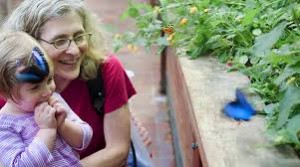I Spy Butterflies!

The Butterfly Garden at the Museum of Science
Butterfly Gardens in Massachusetts show kids metamorphic magic up close
Published in baystateparent magazine
Who isn’t amazed at the captivating beauty of a butterfly, or the unique metamorphosis that transforms a caterpillar into a graceful and gorgeous winged insect? While you don’t have to travel much farther than your backyard to spy New England butterflies, there are opportunities for your child to learn about and see a variety of both local and tropical species up close at one of four indoor gardens in Massachusetts.
“The way a butterfly moves through the air is magical for people of all ages. The fairy-like beauty of their wings, with all the colors and patterns, and their seemingly fragile nature captivate a child’s imagination,” says Maria Mingalone
Director of Interpretation at the Berkshire Museum. The museum’s current exhibit, “Butterflies,” combines first-hand experience of a butterfly pavilion with culturally related arts and objects from around the world.
Butterfly gardens enable children to learn about and see up-close butterflies living in a re-creation of their native environment. Butterfly gardens give visitors an up-front view of the four stages of the butterfly’s short life.
Adult butterflies lay their eggs on a plant specific to their species, so that when the larva (or caterpillars) hatch from the eggs, they can begin to eat the right food for them immediately. Butterfly eggs are extremely tiny, but the hungry caterpillar will instantly start eating the leaves or stalks and begin growing on the plant on which they were born. Once they are fully grown, caterpillars form into a pupa (or chrysalis), a hard casing that protects the butterfly while it undergoes metamorphosis. Quite literally, the caterpillar transforms its tissue, limbs and organs while inside its cocoon, and when done, emerges as a winged butterfly or moth.
Most butterfly gardens have a chrysalis nursery, or box, where butterfly pupa are pinned on display until the butterfly emerges. If you and your child are lucky, you may see a butterfly emerge from its chrysalis, or see a newly emerged butterfly hanging from the pupa encasement, pumping blood into its soft new wings, (a 3-4 hour process) so that it can fly.
Julianna from Littleton, with 3-year-old daughter Sierra recently visited The Butterfly Place in Westford, MA. “It was amazing for her to see the caterpillars and butterflies up close,” she says. “She loved watching them. I learned a lot about butterflies myself. I was surprised by how much I didn’t know. I hope she remembers this experience as she gets older.”
Adult butterfly behavior is also fascinating to watch. Kids can observe how butterflies eat: butterflies have a long coiled straw, called a “proboscis” that uncoils to suck up sweet liquids and nectar. Butterflies live on an all-liquid diet. Since a butterfly’s life is short – just one month on average, and sometime even just a week or two – you may see butterflies with tattered wings – this means they are approaching their end of life, and tiny scales are falling off their wings. Butterflies with brilliant, in-tact wings are ones that have recently undergone their metamorphosis.
You can spy butterflies up high and down low, so keep a sharp eye out and tread lightly – some butterflies may be resting on the ground. If you want a butterfly to land on you, wear white or light clothing, although this is not a guarantee that you or your child will have this special encounter. However, you should know that butterflies should not be handled. Their wings are fragile: the best way to experience butterflies is to look and watch their behavior as a non-intrusive observer, respecting them in their habitat.
“It’s all about observation, says Sylvia Leslie of The Butterfly Place. “Just to have one new thing you or your child sees that says, ‘Wow I never knew that, I never saw that or thought about that’ It’s surprising how many people become aware of dangers for extinction, for example, because of our choices for our own environment.”
Butterfly gardens are lush indoor spaces thriving with tropical plants, an indoor temperature that mimics their habitat, and sometimes glass-enclosed exhibits that show and tell the life story of the butterfly. Since butterflies cannot fly if their body temperature dips below 86 degrees, butterfly gardens are hot and humid, so be sure to dress accordingly, even if you visit in the middle of winter. Butterfly exhibits generally entertain, but also educate about of the endangered future of butterflies. For example, if the host plant that a butterfly depends on for laying eggs begins to become scarce or disappear, that population may be endangered, especially, if the butterfly is a migrating breed like the Monarch.
The Monarchs cover thousands of miles from North America or Canada to Mexico or other South America, and may require two to four generations of their breed to survive the migration from overwintering in warmer climates back up north. Many people consider their host plant, the milkweed, as an undesirable weed, and is being cut down in – threatening the species.
Learning about butterflies is a multifaceted was of understanding this unique insect in our imagination, our specific habitat, and our world. There are four specific butterfly places you can visit with your child to discover and see these magical creatures.
The Butterfly Garden at the Museum of Science, Boston MA
The Butterfly Garden at the Museum of Science is a wonderful, affordable way to learn and experience butterflies up close in the context of a Museum of Science Exhibit. You can add a tour of the Butterfly Place to your museum admission, and learn the four stages of the butterfly life cycle, other interesting facts about butterflies, and most importantly, see up close many butterfly species in a tropical environment tucked into the top floor of the MOS. Hours: Daily, 9:00-5:00 pm; Website: www.mos.org
The Butterfly Place, Weston, MA
The first butterfly place built in Massachusetts, and the fourth in the country, The Butterfly Place in Weston Massachusetts is the result of one family’s passion about butterflies that has captivated thousands of visitors since its opening in 1990. The owner George Leslie saw an article in the Smithsonian Magazine about butterfly gardens, and decided to start his own. The Butterfly Place has tropical birds and koi fish as well in a beautifully landscaped, enclosed space. The Butterfly Place also carries butterfly feeders, books, and butterfly hatching kits, where children can watch caterpillars morph into butterflies in their own home. Summer hours: Daily, 10:00 am -5:00 pm; Website: www.butterflyplace-ma.com
Magic Wings Butterfly Conservatory and Gardens, South Deerfield, MA
See close to 3,000 free flying butterflies, enclosed in an 8,000 square foot conservatory, including a waterfall and Japanese Koi. There are educational videos on butterflies, as well as a restaurant (Monarchs Restaurant) and outdoor butterfly garden (weather permitting) and gift shop. Magic Wings has “Flight Attendants” on staff to answer all your questions about butterflies. Summer hours: Daily 9:00 am – 6 pm; Website: www.magicwings.com
Butterflies Exhibit and Pavilion, Berkshire Museum, Berkshire, MA
This limited-time exhibit and Pavilion combines history, art, and first-hand experience of butterflies in one exhibit., which has been recently extended until October 26, 2014. The Pavilion of live butterflies is at the heart of the exhibit, and features butterflies diverse in varieties and habitats, including both native and exotic breeds. The exhibit features works and artifacts from around the world, and includes information about the butterfly lifecycle and protection of species from extinction. A visit to the Butterflies Pavilion can be added to a Museum admission for $2 per person. Summer hours: Mon-Sat. 10:00 am – 5 pm; Sunday, Noon-5 pm. Website: www.berkshiremuseum.org
 My professional experience includes leading the creative efforts of three companies I have co-owned. I'm a seasoned copywriter/creative director, award-winning journalist, avid runner, and mom of four. Got a story idea you'd like to share? Email me at treske@nowspeed.com. You can also find me on Twitter: @trishreske, LinkedIn and Facebook.
My professional experience includes leading the creative efforts of three companies I have co-owned. I'm a seasoned copywriter/creative director, award-winning journalist, avid runner, and mom of four. Got a story idea you'd like to share? Email me at treske@nowspeed.com. You can also find me on Twitter: @trishreske, LinkedIn and Facebook.